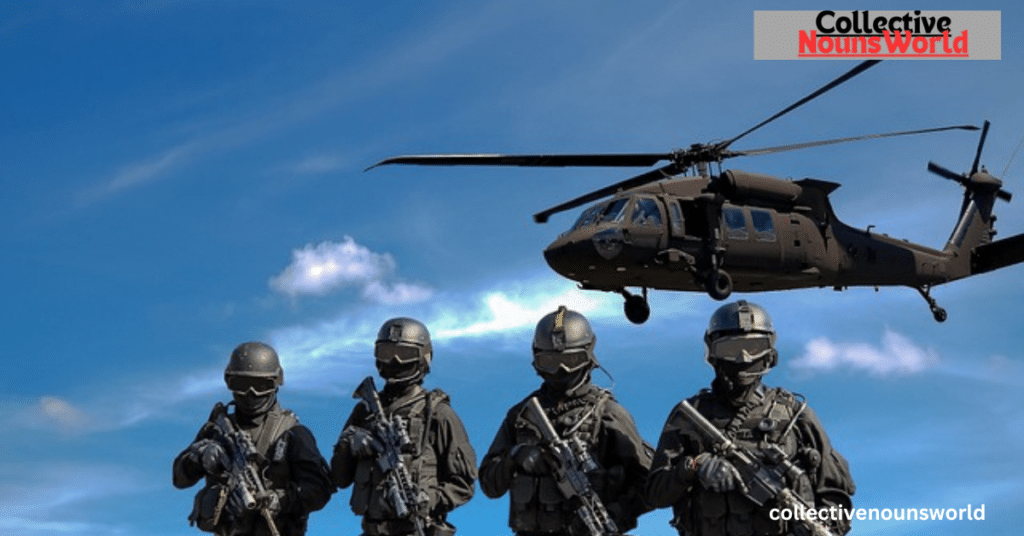Collective nouns are fascinating elements of language, giving us the ability to describe groups with just a single term. These nouns make conversations efficient and help us communicate more effectively. When it comes to the collective noun for soldiers, the English language offers a variety of interesting terms, each with its own history and nuance. In this article, we’ll explore some of the most commonly used collective nouns for soldiers, their significance, and how to use them correctly in sentences.
| Collective Noun | Definition | Size | Example in a Sentence |
| Army | A large organized group of soldiers trained for land warfare. | Varies; can range from thousands to millions. | “The army was called in to defend the nation’s borders.” |
| Battalion | A military unit consisting of several companies of soldiers. | 300 to 800 soldiers. | “The battalion marched into the city at dawn.” |
| Regiment | A unit made up of several battalions, used for both tactical and administrative purposes. | Can consist of several battalions. | “The regiment was known for its bravery during the battle.” |
| Brigade | A military formation consisting of several regiments or battalions. | 3,000 to 5,000 soldiers. | “The brigade was responsible for securing the southern flank.” |
| Platoon | A small group of soldiers that form the lowest tactical military unit. | 30 to 50 soldiers. | “The platoon was sent on a reconnaissance mission.” |
| Company | A subdivision of a battalion, typically commanded by a captain. | 100 to 200 soldiers. | “The company advanced through enemy territory cautiously.” |
| Squad | A small team of soldiers, usually a subset of a platoon. | 8 to 14 soldiers. | “The squad was assigned to guard the outpost overnight.” |
What Are Collective Nouns and Why Are They Important?
Collective nouns are words that describe groups of people, animals, or things as a single entity. In the world of language, they’re crucial for bringing clarity and specificity to communication. For example, instead of saying “a group of birds,” we use “a flock of birds.” Similarly, instead of “a group of soldiers,” we use terms like battalion, platoon, or regiment.
The use of collective nouns is not just a matter of grammar—it reflects history, culture, and organization. When talking about soldiers, understanding the right collective nouns can help you gain insights into the structure and hierarchy of military forces, from ancient times to modern-day armies.
Read more The Blooming World: What is the Collective Noun for Flowers?
Defining the Collective Noun for Soldiers
The collective noun for soldiers depends on the context and the size of the group you’re referring to. Some of the most commonly used terms include:
- Army: This refers to a large organized group of soldiers, typically trained for land-based warfare. Historically, an army could be as small as a few thousand men or as large as millions during global conflicts.
- Battalion: A battalion is a military unit made up of several companies of soldiers. It usually contains between 300 to 800 soldiers and is commanded by a lieutenant colonel.
- Regiment: A regiment is a military unit of ground forces that can contain several battalions. It is an important tactical formation and is led by a colonel.
- Brigade: A brigade consists of multiple regiments or battalions, generally numbering between 3,000 to 5,000 soldiers. This term is often used in both tactical and administrative military contexts.
- Platoon: A platoon refers to a small group of soldiers, typically 30 to 50, led by a lieutenant or second lieutenant. Platoons are the smallest units in the military hierarchy that can conduct independent tactical operations.
Each of these collective nouns plays a key role in describing the organizational structure of military forces and their deployment.
Read more The Wondrous World of Rats: Discovering Their Collective Names
Collective Nouns for Soldiers: A Historical Perspective
The terminology used to describe groups of soldiers has evolved alongside military organization and tactics. In ancient times, armies were referred to simply as “legions” or “hordes,” depending on the civilization in question. The Romans, for example, used legion as a collective noun for a large military unit composed of thousands of soldiers. As military strategies became more complex, new terms emerged to define smaller units within larger forces.
During the Middle Ages, terms like regiment and battalion were adopted from French and Latin, reflecting the highly structured nature of medieval armies. As warfare became more specialized during the modern era, terms like platoon and brigade were developed to describe more specific tactical formations.
Specific Collective Nouns for Soldiers: Breaking Them Down
1. Army
An army is the broadest term used to describe a large group of soldiers organized for warfare, typically on land. It can range from a small military force to a massive body of troops involved in global conflict. An army is usually divided into smaller units, including regiments, battalions, and platoons.
2. Battalion
A battalion is typically composed of 300 to 800 soldiers, divided into companies and platoons. This unit is often deployed for major military operations and can function independently in some cases.
Example in a sentence:
“The battalion advanced through the dense forest, ready for the next phase of their mission.”
3. Regiment
A regiment is a formal military unit consisting of several battalions. This collective noun has been used for centuries and still holds an important place in modern armies.
Example in a sentence:
“The regiment held their ground, displaying remarkable courage under heavy enemy fire.”
4. Brigade
A brigade is a larger collective noun for soldiers, usually numbering 3,000 to 5,000 troops. This group is typically commanded by a brigadier general or colonel, and it plays a significant role in large-scale military operations.
Example in a sentence:
“The brigade was deployed to reinforce the frontline positions as the battle raged on.”
5. Platoon
A platoon is one of the smallest units in the army, usually made up of 30 to 50 soldiers. It is led by a lieutenant and is often tasked with specialized missions that require rapid movement and precise coordination.
Example in a sentence:
“The platoon moved swiftly through the village, securing key positions before dawn.”
Read more The Amazing World of Cows: Discover Collective Noun for Cows
Usage of Soldiers’ Collective Nouns in Everyday Language
Understanding the context in which each collective noun is used is important, not just for military experts but also for anyone writing about or discussing military affairs. Here are a few examples of how these terms can be used in sentences:
- The army was deployed to protect the nation’s borders.
- The battalion of soldiers arrived at the base after a long march.
- A regiment of elite troops was sent to the conflict zone.
- The brigade received orders to support the southern flank.
- The platoon conducted a successful raid on the enemy camp.
These terms can be applied beyond military settings, such as in metaphors or analogies to describe teamwork, discipline, and organization in other areas of life.
Regional Variations in Military Collective Nouns
While terms like army, battalion, and platoon are widely used across English-speaking countries, there are some regional variations in military terminology. For instance, in the British Army, the term company is often used instead of battalion, while in the United States, squadron may be used for certain military units in the Air Force or cavalry.
In some countries, historical terms may still be in use. For example, in India, brigade and division are still frequently used in military contexts, while older terms like legion may be used in historical or symbolic contexts.
Read more What is the Collective Noun for Papers?
Fun Facts and Trivia About Collective Nouns for Soldiers
Collective nouns for soldiers have some fascinating origins and quirks:
- The term legion originated in ancient Rome, where a legion referred to a large military unit of 5,000 men. Today, legion is still used metaphorically to describe large, organized groups.
- The word battalion comes from the Italian word battaglione, which means “battle unit” and has been in use since the 16th century.
- In modern military jargon, you might hear phrases like company or squad, both referring to specific, smaller units within a larger army.
Conclusion:
Collective nouns like battalion, platoon, army, and regiment are more than just grammatical constructs—they reflect the organization, history, and tactical functions of military forces. Understanding these terms not only helps in comprehending military structures but also adds precision to any writing or conversation about warfare, history, or modern defense strategies.

Luna Jasper is an experienced blogger with a passion for language and grammar. At **Collective Nouns World**, she shares her expertise in exploring the fascinating world of collective nouns, making learning both engaging and fun. With years of writing and research under her belt, Luna’s insightful articles help readers understand and appreciate the English language.







